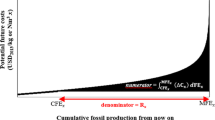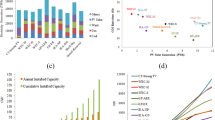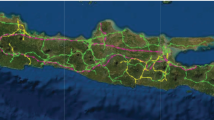Abstract
Purpose
Renewable energies are promoted in order to reduce greenhouse gas emissions and the depletion of fossil fuels. However, plants for renewable electricity production incorporate specifically higher amounts of materials being rated as potentially scarce. Therefore, it is in question which (mineral) resources contribute to the overall resource consumption and which of the manifold impact assessment methods can be recommended to cover an accurate and complete investigation of resource use for renewable energy technologies.
Methods
Life cycle assessment is conducted for different renewable electricity production technologies (wind, photovoltaics, and biomass) under German conditions and compared to fossil electricity generation from a coal-fired power plant. Focus is given on mineral resource depletion for these technologies. As no consensus has been reached so far as to which impact assessment method is recommended, different established as well as recently developed impact assessment methods (CML, ReCiPe, Swiss Ecoscarcity, and economic scarcity potential (ESP)) are compared. The contribution of mineral resources to the overall resource depletion as well as potential scarcity are identified.
Results and discussion
Overall resource depletion of electricity generation technologies tends to be dominated by fossil fuel depletion; therefore, most renewable technologies reduce the overall resource depletion compared to a coal-fired power plant. But, in comparison to fossil electricity generation from coal, mineral resource depletion is increased by wind and solar power. The investigated methods rate different materials as major contributors to mineral resource depletion, such as gallium used in photovoltaic plants (Swiss Ecoscarcity), gold and copper incorporated in electrical circuits and in cables (CML and ReCiPe), and nickel (Swiss Ecoscarcity and ReCiPe) and chromium (ESP) for stainless steel production. However, some methods lack characterization factors for potentially important materials.
Conclusions
If mineral resource use is investigated for technologies using a wider spectrum of potentially scarce minerals, practitioners need to choose the impact assessment method carefully according to their scope and check if all important materials are covered. Further research is needed for an overall assessment of different resource compartments.


Similar content being viewed by others
References
Breeze P (2014) Power generation technologies, 2nd edn. Elsevier, Oxford
Buchert M, Schüler D, Bleher D (2009) Critical metals for future sustainable technologies and their recycling potential. http://www.oeko.de/oekodoc/1070/2009-129-en.pdf. Accessed 17.09.2015
German Federal Network Agency (2012) List of power plants. Net power 10 MW. www.bundesnetzagentur.de. Accessed 17.09.2015
BSW (2012) Statistische Zahlen der deutschen Solarstrombranche (Photovoltaik). http://www.solarwirtschaft.de/fileadmin/media/pdf/bsw_solar_fakten_pv.pdf. Accessed 01.04.2013
Burger B, Bauer C (2007) Windkraft. In: Dones R et al. (ed) Sachbilanzen von Energiesystemen: Grundlagen für den ökologischen Vergleich von Energiesystemen und den Einbezug von Energiesystemen in Ökobilanzen für die Schweiz. Final report ecoinvent No. 6-XIII, Paul Scherrer Institut Villingen. Swiss Centre for life cycle inventories, Dübendorf, CH
Davidson S, Höök M, Wall G (2012) A review of life cycle assessments on wind energy systems. Int J Life Cycle Assess 17(6):729–742
DENA (2010) Kurzanalyse der Kraftwerksplanung in Deutschland bis 2020 (Aktualisierung). http://www.dena.de/presse-medien/studien/2010/kraftwerksplanung.html, Accessed 17.09.2015
Dewulf J, Benini L, Mancini L, Sala S, Blengini GA, Ardente F, Recchioni M, Maes J, Pant R, Pennington D (2015) Rethinking the area of protection "natural resources" in life cycle assessment. Environ Sci Technol 49:5310–5317
Drielsma JA, Russell-Vaccari AJ, Drnek T, Brady T, Weihed P, Mistry M, Perez Simbor L (2016) Mineral resources in life cycle impact assessment – defining the path forward. Int J Life Cycle Assess 21:85–105
European Commission (2010a) Critical raw materials for the EU: Report of the Ad-hoc Working Group on defining critical raw materials. https://ec.europa.eu/eip/raw-materials/en/community/document/critical-raw-materials-eu-report-ad-hoc-working-group-defining-critical-raw. Accessed 17.09.2015
European Commission (2010b) International Reference Life Cycle Data System (ILCD) Handbook. Publications Office of the European Union, Luxembourg
Frischknecht R, Büsser Knöpfel S (2013) Ökofaktoren Schweiz 2013 gemäß der Methode der ökologischen Knappheit – Methodische Grundlagen und Anwendung auf die Schweiz. Bundesamt für Umwelt, Bern
Goedkoop M, Heijungs MR, Huijbregts HR, De Schryver A, Struijs J, Van Zelm R (2013) ReCiPe 2008 – a life cycle impact assessment method which comprises harmonised category indicators at the midpoint and the endpoint level. http://www.pre-sustainability.com/recipe-report, Accessed 17.09.2015
Guezugara B, Zauner R, Pölz W (2012) Life cycle assessment of two different 2 MW class wind turbines. Renew Energ 37(1):37–44
Guinee JB, Gorrée M, Heijungs R, Huppes G, Kleijn R, De Koning A, Van Oers L, Wegener Sleeswijk A, Suh S, De Haes UHA, De Bruijn H, Van Duin R, Huijbregts MAJ (2004) Handbook on life cycle assessment – operational guide to the ISO standards. Kluwer Academic Publishers, New York and others
Haapala KR, Prempreeda P (2014) Comparative life cycle assessment of 2.0MW wind turbines. Int J Sustainable Manufactur 3(2):170–185
Hauschild MZ, Goedkoop M, Guinée JB, Heijungs R, Huijbregts M, Jolliet O, Margni M, De Schryver A, Humbert S, Laurent A, Sala S, Pant R (2012) Identifying best existing practice for characterization modeling in life cycle impact assessment. Int J Life Cycle Assess 18(3):683–697
Herbst W, Faht P, Jooß W, Feilmeier F-J (2009) Webcast: centrotherm’s “grid parity factory” Controtherm Photovoltaics. http://www.centrotherm.de/fileadmin/ct_group/Downloads/IR_Sonstige/Konferenzen/090204_WebCast_IntegrierteFabrik_EN.pdf, Accessed 17.09.2015
IWES (2014) Windmonitor. http://www.windmonitor.de/. Accessed 20.03.2015
Joint Research Centre (2012) Product environmental footprint (PEF) guide. http://ec.europa.eu/environment/eussd/pdf/footprint/PEF%20methodology%20final%20draft.pdf. Accessed 21.02.2016
Jungbluth N, Stucki M, Frischknecht R (2009) Photovoltaics: Ecoinvent report No. 6-XII: Data v2.0, In: Dones R et al. (ed), Sachbilanzen von Energiesystemen: Grundlagen für den ökologischen Vergleich von Energiesystemen und den Einbezug von Energiesystemen in Ökobilanzen für die Schweiz. Swiss Centre for life cycle inventories, Dübendorf, CH
Kaltschmitt M (2012) Wärme und Strom aus fester Biomasse: Stand und Perspektiven: Vortrag im Rahmen der Ringvorlesung Regenerative Energien für Wärme und Strom. http://www.tuhh.de/t3resources/iue/docs/veranstaltungen/RingvorlesungSommer2012/Vortrag-Prof-Kaltschmitt-15.06.12.pdf. Accessed 17.09.2015
Kaltschmitt M, Streicher W, Wiese A (2013) Erneuerbare Energien, 5th edn. Springer Vieweg, Berlin Heidelberg
Klinglmair M, Sala S, Brandao M (2013) Assessing resource depletion in LCA: a review of methods and methodological issues. Int J Life Cycle Assess 19(3):580–592
Mancini L, De Camilis C, Pennington D (eds) (2013) Security of supply and scarcity of raw materials – towards a methodological framework for sustainability assessment. Publications Office of the European Union, Luxembourg
Martinez E, Sanz F, Pellegrini S, Jimenez E, Blanco J (2009) Life cycle assessment of a multi-megawatt wind turbine. Renew Energ 34(3):667–673
Meadows DH, Meadows DL, Rander J, Behrens W (1972) The limits to growth. Universe Books, New York
National Research Council (2008) Minerals, critical minerals, and the U.S. economy. National Academies Press, Washington DC
Nill M (2004) Die zukünftige Entwicklung von Stromerzeugungstechniken. Hamburg University of Technology, Dissertation
Schneider L (2014) A comprehensive approach to model abiotic resource provision capability in the context of sustainable development. Dissertation, TU Berlin
Schneider L, Berger M, Schüler-Hainsch E, Knöfel S, Ruhland K, Mosig J, Bach V, Finkbeiner M (2013) The economic resource scarcity potential (ESP) for evaluating resource use based on life cycle assessment. Int J Life Cycle Assess 19(3):601–610
Siemens (2009) Neue Maßstäbe - Siemens Windenergieanlage SWT-3.6-107. http://www.energy.siemens.com/hq/pool/hq/power-generation/wind-power/brochures%20german/siemens_windenergieanlage_swt-3.6-107.pdf, Accessed 17.09.2015
Sonnemann G, Gemechu ED, Adibi N, De Bruille V, Bulle C (2015) From a critical review to a conceptual framework for integrating the criticality of resources into Life Cycle Sustainability Assessment. J Clean Prod 94:20–34
Swiss Centre for life cycle inventories (2014) Ecoinvent v3.1. Life cycle inventory database. http://www.ecoinvent.org, Accessed 24.06.2016
Thrän D, Bunzel K, Seyfert U et al. (2010) Globale und regionale räumliche Verteilung von Biomassepotenzialen - Status Quo und Möglichkeit der Präzisierung. https://www.dbfz.de/fileadmin/user_upload/Berichte_Projektdatenbank/bmvbs_DL_ON272010-1.pdf, Accessed 17.09.2015
U.S. Department of Energy (2010) Critical Materials Strategy. http://www.osti.gov/scitech/servlets/purl/1000846, Accessed 17.09.2015
Vestas (2011) Life Cycle Assessment of Electricity Production from a Vestas V112 Turbine Wind Plant. https://www.vestas.com/~/media/vestas/about/sustainability/pdfs/lca_v112_study_report_2011.pdf, Accessed 17.09.2015
Weinberg J (2014) Die zukünftige Entwicklung der straßengebundenen Mobilität in Deutschland. Hamburg University of Technology, Dissertation
Weinberg J, Kaltschmitt M (2012) Life cycle assessment of electric cars and electric hybrids in comparison to conventional vehicles. http://www.ifu.com/en/download-center/umberto/workshop2012/, Accessed 17.09.2015
Wetzel T, Feuerstein F (2011) Update of energy payback time data for crystalline silicon PV modules. http://www.eupvsec-proceedings.com/proceedings?paper=14933, Accessed 17.09.2015
Witt J, Thrän D, Rensberg N, Hennig C, Naumann K, Billig E, Sauter P, Krautz A, Daniel-Gromke J, Weiser C, Reinhold G, Graf T (2012) Monitoring zur Wirkung des Erneuerbare- Energien-Gesetz (EEG) auf die Entwicklung der Stromerzeugung aus Biomasse: Endbericht zur EEG-Periode 2009 bis 2011. https://www.dbfz.de/fileadmin/user_upload/Berichte_Projektdatenbank/3330002_Stromerzeugung_aus_Biomasse_Endbericht_Ver%C3%B6ffentlichung_FINAL_FASSUNG.pdf, Accessed 17.09.2015
Acknowledgments
This work was supported by a fellowship within the Postdoc Program of the German Academic Exchange Service (DAAD).
Author information
Authors and Affiliations
Corresponding author
Ethics declarations
Conflict of interest
The authors declare that they have no conflict of interest.
Additional information
Responsible editor: Steven B. Young
Electronic supplementary materials
Below is the link to the electronic supplementary material.
ESM 1
(PDF 91 kb)
Rights and permissions
About this article
Cite this article
Lieberei, J., Gheewala, S.H. Resource depletion assessment of renewable electricity generation technologies—comparison of life cycle impact assessment methods with focus on mineral resources. Int J Life Cycle Assess 22, 185–198 (2017). https://doi.org/10.1007/s11367-016-1152-3
Received:
Accepted:
Published:
Issue Date:
DOI: https://doi.org/10.1007/s11367-016-1152-3




